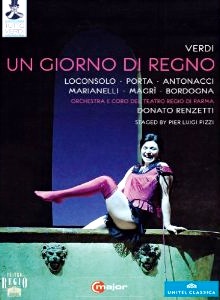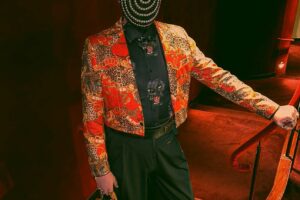
There’s that old joke; What’s the difference between opera and sex? Punchline; you can have good sex. That hoary chuckler becomes a near-Aristotelian axiom when presented with this recent release
from C Major of Giuseppe Verdi’s Un giorno di regno, the latest episode in the Teatro Regio di Parma’s systematic attempt to defile the reputation of its most revered musical son in the year of his bicentennial one mediocre production at a time.
But I come to praise Verdi, not to bury him.
The nifty introduction to this opera that’s accessed from the DVD’s top menu tells us that Verdi’s first attempt at comedy came about because of his contractual obligation to the then impresario of La Scala who, in a moment of thrift, presented the young composer with a number of existing libretti to choose from and set to music. Verdi is quoted as saying he tried to pick the one that was “least bad.” We are also informed that of the Verdi canon it is the least performed save Giovanna d’Arco.
La Scala apparently cancelled the remaining performances in the initial run in September 1850 but didn’t abandon it completely since they mounted it again in 2001. The most macabre portion of the tale of its composition finds Verdi losing his entire family to illness during the course of its writing, his two young children in the two years preceding and then his wife just 11 weeks before the prima. Certainly the continuously mournful environment made it nearly impossible to nurture a charming comedy of manners.
Though filmed in January 2010, this is actually a revival of Teatro Regio’s 1997 production that was designed and directed by the venerable Pier Luigi Pizzi. In fact, the sets could easily serve as a sort of opera house starters’ kit. These dividable staircases, loggias, decorative obelisks—all on magic casters and flying facades—could easily serve Mozart’s Da Ponte operas to say nothing of a host of 18th century works. But you’d have to throw a dash of color on them since these have all been lovingly rendered in relentless beige. So, specific or characterful this production is not, I’m afraid. Costumes are all monochromatic which means that each character in the plot has been splashed with one color. I’m sad to report that the majority of the performances make the same impression.
The plot. Oh really, must I? Stop me if you’ve heard any of this before. The Baritone Baron of Kelbar has this cute little soprano daughter who’s betrothed to the old bass Signor La Rocca in spite of the fact that she’s really in love with his tenor nephew Edoardo. Meanwhile, the Cavaliere di Belfiore, another baritone, has abandoned his fianceé so as to impersonate the reigning monarch while he’s out of town defending his claim to the throne. The aforementioned affianced, mezzo La Marchesa di Poggio, has hastily arranged a wedding of her own to the tenor Count Ivrea in order to save her honor. Naturally, circumstance throws everyone unexpectedly under the same roof in the hopes that hilarity and mirth will ensue.
The majority of the cast can be dispatched fairly quickly. The two basses, Andrea Porta as Kelbar and Paolo Bordogna as La Rocca, serviceable voices both, play off each other in the same traditional manner that hasn’t changed since the birth of commedia dell’arte. The prosciutto is sliced thick with these two and I wish we all got more of a meal out of it.
We’re given a pair of age appropriate young lovers for a change. Soprano Alessandra Marianelli and tenor Ivan Magri brighten the proceedings when they’re not looking forlorn or sullen. Mr. Magri has a very nice ping to his tenore di grazia and he knows how to build sound without pushing. It’s not a big voice but it seems like it carries well and he exhibits a graceful and steady line. I only wished he’d have the good sense to pull his hair away from his face so we could see what he looks like. Checking up on the interwebs I see he’s represented by Ernesto Palacio (remember him?) which makes me sigh with relief that he’s in good hands.
Our callow soubrette exhibits a voice that may mature into something more wonderful than what is actually bringing us modest enjoyments now. She still seems to be finding her way a bit matching up the alternate poles of her instrument. Pizzi, and Verdi for that matter, give her a lovely entrance with the ladies of the chorus in a fetching polonaise and she builds from there.The top seems very secure but also a little manufactured rather than free spinning.and I sense that she’ll do well with a bit more seasoning and polish. Fingers crossed.
Baritone Guido Lonconsolo needs no more seasoning and is the only gentleman onstage playing with a modicum of sexual charisma. As the titular King for a day he sings with grace and charm, after a slightly lumpy start with some smudged fioratura, moves well and generally makes the rest of his castmates look like they’re just not trying
Until, that is, the entrance of Anna Caterina Antonacci as La Marchesa when you start hoping that this poor provincial cast will actually have the fortitude to survive what’s about to happen to them. Our Italian diva in excelsis takes the stage—and doesn’t give it back. It’s as if a little spotlight has been trained on her by the theatre gods to accompany her throughout her life. Every move, every gesture, is considered and executed with taste and maximum theatrical effect. Her first cadenza, moments after her entrance, hurls down the vocal flag for Verdi and plants if firmly in her corner.
Not that it’s a perfect voice mind you, or ever was; she is, however, the absolute mistress of her instrument. Her character has been recently widowed but, she’s Italian so, she’s already moved on to purple when we first discover her. She really appears to be the only one who gets the directors “pieces on a chessboard” staging concept and she does a delightful little striptease during her first aria while she draws her bath. If only her performance were enough to put this whole thing over!
I have no idea what is going on in the pit but the lesser members of the cast, meaning anyone who isn’t Antonacci and Lonconsolo, can’t take their eyes off the conductor Donato Renzetti. I wish I could say this diligence helped matters. Throughout the evening Maestro Renzetti displays the deft touch of a rampaging wildebeest. If you closed your eyes and just listened without knowing the libretto you’d swear we were being steeped in tragedy.
Interesting, for a change, that the overture is actually based on the primary theme from the finale. Odder still that the most prominent instrument in said overture seems to be the triangle. Other than that the whole score sounds like Donizetti and Rossini meeting in a food processor on its highest setting.
It’s hard to say who’s at fault here: the mostly provincial cast, the hard-driving conductor or a composer still feeling his way before he understands the fabric of the orchestra.
Picture is sharp and sound is DTS excellent with subtitles in seven languages. If you’re an Antonacci completist it would be excuse enough but, honestly, I can’t see this release doing much but gathering dust on your shelf. Meanwhile, Hardy Classics has just released the prima of this production from back in 1997 with Antonacci joined by Paolo Coni, Cecilia Gasdia (remember her?) and conducted by Maurizio Benini. That might be worth a second hearing.



























Comments